Supporting evaluation components of the Lake Huron Technical Committee’s Cisco reintroduction study: a multi-agency effort to promote Cisco recovery in the western main basin of Lake Huron (FY22)
Contributing Authors
Jose Bonilla-Gomez (USFWS, jose_bonillagomez@fws.gov), Timothy O’Brien (USGS), Amanda Ackiss (USGS)
Executive Summary
The U.S. Fish and Wildlife service conducted larval coregonine surveys in 2022 aimed at documenting the current distribution, composition, and density of the larval coregonid community in Saginaw Bay. Sampling of the ichthyoplankton community was limited to pelagic neuston net tows and beach seining. Pelagic ichthyoplankton surveys were conducted weekly at 40, randomly selected, spatially balanced, depth stratified sites throughout Saginaw Bay from April 7th and May 12th, 2022 (Figure 1). During each ichthyoplankton sample larvae were sampled within 1m of the surface using a 500-µm, 2 x 1m neuston net. Larval coregonine were present in each depth bin >3m throughout the entire bay in six weeks of sampling. Observed larval coregonid densities of individual neuston tows ranged between 0 and 0.38 individuals/m3 with sampled coregonid larvae ranging between 7.31 and 20.95 mm in total length. Observed larval coregonid densities pooled across sampling weeks and depth bins indicated that densities were low during the sampling period and 2022 appeared to be a poor year for coregonid production in general (Figure 2). We relied on genetics to identify larval fish samples. Approximately 448 larval coregonine from Saginaw Bay were made available for genetic sequencing, where no Cisco (Coregonus artedi) was detected, and all were Lake Whitefish (Coregonus clupeaformis) confirmed. Following larval fish sampling, age-0 coregonines were sampled using onshore beach seines. Beach seining was done at 4 sites on both sides of Saginaw Bay (Tawas, Au Gres, Caseville, and Jenks Park). Beach seines (50 m in length, 3.175 mm mesh) were conducted between June 7th – June 28th, 2022, at each site. A total of 17 young-of-year Lake Whitefish (mean total length 39.70 mm) were sampled during the sampling in Saginaw Bay. Unfortunately, no other coregonines were observed during any of the other beach seines. In August 2022, an acoustic survey (acoustic transects and midwater trawls) was conducted by Michigan DNR to assess post-stocking survival of Cisco, but no Cisco were captured. Additionally, in the Fall of 2022 we implemented a spawning gill net survey to sample spawning adults in Saginaw Bay. The fall of 2022 was the initial year that the first-year class of stocked Cisco may have reached maturity (age 4), assuming the 2018-year (single marked but stocked in fall due to logistics) class survived and returned to spawn in Saginaw Bay. We were able to sample 29 sites between November 10th and December 12th (Figure 3). Overnight gill nets were set on sites adjacent to the stocking locations, and in other sites along the bay (Figure 4). To confirm their hatchery origin and release season of all Cisco caught in Saginaw Bay during the Fall spawning survey, we used a methodology of detection with florescence microscopy, where all specimens were evaluated for the presence of oxytetracycline hydrochloride (OTC) marks in the vertebras of the caudal peduncle (Figure 5). Each vertebra was exposed under a stereoscope (8-40X magnification) with an ultraviolet light (~365 nm) between 3 and 6 minutes in the centrum area in a cross-section position. Each vertebra was then examined for a circle fluorescent OTC mark. Circle mark quantity was graded 0 (no mark, presumed wild), 1 (spring release), and 2 fall release). Otoliths were used to estimate age of all specimens collected. Of the 49 adult spawning Cisco caught (362 mm mean total length) from sites outside of the Au Gres River mouth (Figure 2), 46 were of hatchery origin and 3 were presumed wild. For the three fish without OTC marks, genetic test results confirmed that 1 was likely from hatchery origin (assigning with high similarity to the Les Cheneaux strain) for which the OTC mark did not take, one was likely wild (assigning with high certainty to the Bruce/Saugeen Peninsula strain), and one was inconclusive (assigning as a putative hybrid between the two stocks). Based on the presence of OTC mark, this work has documented for the first time that stocked Cisco survive to maturity and returned to historical spawning locations in Saginaw Bay. The OTC marks analysis showed 93.8% of the specimens were spring release, 4.1% were fall release, and 2.1% were wild. For now, these initial results suggest hatchery Cisco stocked can survive and spawn in Saginaw Bay, however it is yet to be determined if they can produce viable recruits.
Outcomes
Samples from all surveys were processed and larval coregonid density and species composition throughout Saginaw Bay in 2022 was monitored. Beach seine surveys were successfully performed near previous Cisco stocking locations.
Analyzed 448 larval coregonid for genetic-based species assignment, but no larval Cisco were detected.
We developed a better understanding of the spatial and temporal variation inherent in the sampling of larval coregonines in Saginaw Bay.
Developed sampling protocol for fall gillnet spawner survey of adult Cisco.
A total of 47 mature individuals of hatchery origin were recaptured, another one recaptured was assigned as a putative hybrid, and one wild mature Cisco was confirmed.
